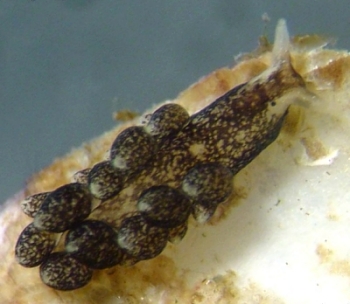
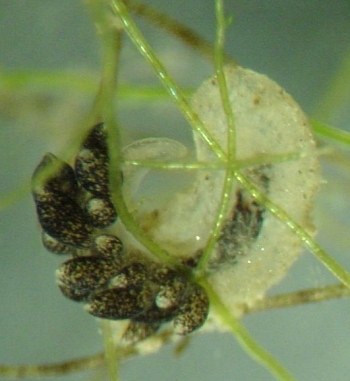
Calliopaea bellula
Orbigny, 1837
Order: SACOGLOSSA
Family: Limapontiidae
DISTRIBUTION
Recorded in northeastern Atlantic from Norway down to the Mediterranean and Black Sea.
PHOTO
Locality: Audenge, Bassin d'Arcachon, 1 m, France, Atlantic Ocean, 09 October 2006, mud with algae. Length: 5mm. Lower photo showing animal feeding on eggs of Haminoea. Photographer: Marina Poddubetskaia.
Note added 26 March 2009: This species was previously known on the Forum as Stiliger bellulus.
The animal is translucent greenish or grey with a heavy mottling of black over the body and cerata. The rhinophores, sides of the head and tips of the cerata lack black pigmentation. The cerata are relatively short, but very inflated, and arranged in about 6 rows on each side of the body. The rows do not start until about half way down the body, leaving the anterior half of the body clear. It grows to about 10 mm in length.
As a sacoglossan, we might expect to find this species feeding on algae, but Bernard Picton's message below suggests that it feeds on Philine eggs (and possibly other opisthobranch eggs). Since then there has been an interesting report from Portugal (Coelho et al., 2006), showing it feeding exclusively on the eggs of Haminoea orbignyana. As Bernard Picton suggested, this raises the possibility that Calliopaea oophaga Lemche, 1974 (named for its habit of eating Philine eggs and which grows to no more than 3 mm in length) is possibly based on a juvenile of Calliopaea bellula (see Thompson & Brown, 1984 for discussion). Thompson also mentions that the Mediterranean species Stiliger vesiculosus is also oophagous and possibly a synonym. I have discussed this issue with Kathe Jensen who is the opinion that we cannot be sure until the genus is properly reviewed. Also its relationship with the genus Stiliger is also insoluble until that genus is adequately reviewed.
Despite these nomeclatural problems, this is an extremely interesting animal, having evolved from ancestors which fed on the cell sap of algae to feeding on the eggs of other opisthobranchs. The way the anterior part of the body is bare of cerata apparently to allow them to poke their heads far into egg masses reminds me of the necks of carrion-eating vultures, which are bare of feathers to assist them in poking their heads far into carcases.
-
Coelho, R., Malaquias, M. A. E. & Calado, G. (2006) Calliopaea bellula feeding upon egg-masses of Haminoea orbignyana: oophagy among opisthobranch molluscs. Journal of the marine biological Association, U.K., 86.
-
Gascoigne, T. & Sigurdsson, J. B. (1977) Calliopaea oophaga Lemche, 1974, a species new to the British Fauna (Opisthobranchia: Sacoglossa) Journal of Molluscan Studies, 43, 286-289.
-
Gascoigne, T. & Todd, C. D. (1997) A description of a specimen of Calliopaea bellula D'Orbigny, 1857 found at Robin Hood's Bay, North Yorkshire (Opisthobranchia: Sacoglossa). Journal of Molluscan Studies, 43, 290-295.
-
Jensen, K. R. (1986) Observations on feeding, copulation and spawning of the ascoglossan opisthobranch Calliopaea oophaga Lemche. Ophelia, 25(2), 97-106.
-
Orbigny, A.d'. (1837). Memoire sur des especes et sur des genres nouveauz de l'ordre des nudibranches, observes sur les cotes de France. Magasin de Zoologie 7: 1-16.
-
Todd, C. D. (1982) Further observations on the ascoglossan opisthobranch Calliopaea bellula D'Orbigny. Journal of Molluscan Studies, 48, 101-102.
-
Thompson, T.E., 1988. Molluscs: benthic opisthobranchs (Mollusca: Gastropoda). Synopses of the British Fauna, New Series, Linnean Society. London, 2nd edn., no. 8.
-
Thompson, T.E. & Brown, G.H., 1984. Biology of opisthobranch molluscs, vol. II. London: The Ray Society.
Rudman, W.B., 2009 (March 26) Calliopaea bellula Orbigny, 1837. [In] Sea Slug Forum. Australian Museum, Sydney. Available from http://www.seaslugforum.net/find/callbell
Related messages
Calliopaea bellula feeding behaviour
March 26, 2009
From: Marina Poddubetskaia Ossokine
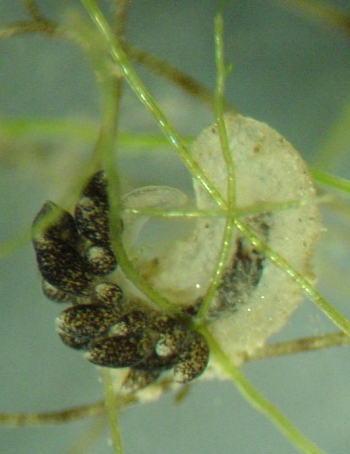
To complete my previous message [#22349] about Calliopaea bellula, here are the photos of Calliopaea feeding on Ercolania viridis eggs and on Haminoea eggs (I couldn't say which species, we have several ones in Arcachon).
Locality: L'Ecluse de Verdurette, Domaine de Graveyron, Audenge, Bassin d'Arcachon, 1 m, France, Atlantic , 09 October 2006.
Upper photo: 5 mm long animal feeding on Haminoea eggs.
Lower photo: 3.5 mm long animal feeding on Ercolania eggs. Photographer: Marina Poddubetskaia.
It's interesting to see how Calliopaea puts its head and the upper part of its body inside the egg ribbon to eat eggs. Please, let me know if you want more photos of it.
Best wishes,
Marina.
Photos: Marina Poddubetskaia - Nembro website
nembro@yahoo.fr
Poddubetskaia Ossokine, 2009 (Mar 26) Calliopaea bellula feeding behaviour. [Message in] Sea Slug Forum. Australian Museum, Sydney. Available from http://www.seaslugforum.net/find/22350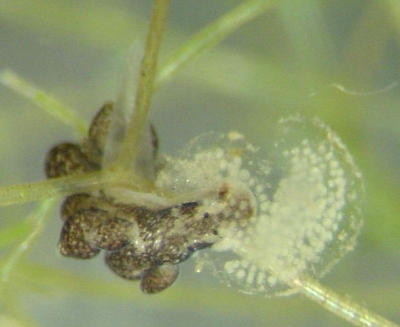
Dear Marina,
Thanks very much. Your upper photo shows rather clearly why it is an advantage for this species to keep the front half of its body free of cerata, so that it can extend deep into egg sacs to eat the individual eggs. Are you sure the lower egg mass is of Ercolania viridis? We have a couple of photos on the Forum of this species' egg ribbon and they are both rather different.
Be that as it may, the two different egg masses being eaten by this species suggest that it does feed on more than one species. In Coelho, Malaquias & Calado's recent report on this species, they found it would only eat the egg masses of Haminoea orbignyana. Your two different egg masses, and Bernard Picton's report of it feeding on Philine [message #680] suggest it feeds on a number of opisthobranch egg masses. The other egg masses tested by Coelho et al may well be distasteful to Calliopaea, but it does not necessarily mean that all other egg masses are.
- Coelho, R., Malaquias, M. A. E. & Calado, G. (2006) Calliopaea bellula feeding upon egg-masses of Haminoea orbignyana: oophagy among opisthobranch molluscs. Journal of the marine biological Association, U.K., 86.
Best wishes,
Bill Rudman
Calliopaea bellula from Arcachon Bay
March 26, 2009
From: Marina Poddubetskaia Ossokine
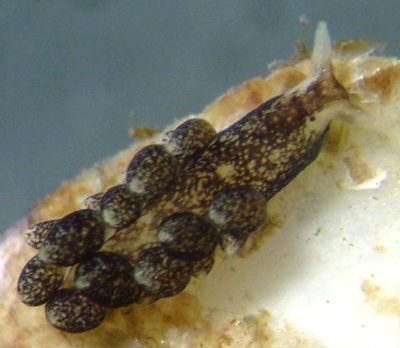
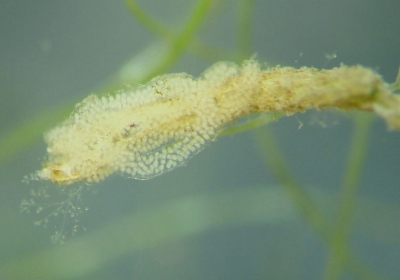
Dear Bill,
In Arcachon Bay we have an interesting species, Calliopaea bellula. And as you don't seem to have it on the Forum, I'd like to share these photos with you.
To start, here are the photos of the animal and its own egg-ribbon. In the separate message [#22350 ] I will send the feeding behaviour of this species.
Locality: Audenge, Bassin d'Arcachon, 1 m, France, Atlantic Ocean, 09 October 2006, muddy with algae. Length: animal : 5mm / eggs : 3mm. Photographer: Marina Poddubetskaia.
Best wishes,
Marina.
Nembro website
nembro@yahoo.fr
Poddubetskaia Ossokine, M., 2009 (Mar 26) Calliopaea bellula from Arcachon Bay. [Message in] Sea Slug Forum. Australian Museum, Sydney. Available from http://www.seaslugforum.net/find/22349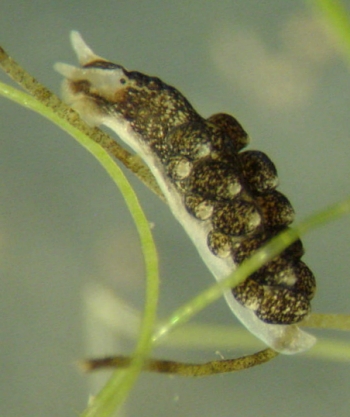
Dear Marina,
Thanks for the wonderful photos in this and your following message. It's always intersting to get information on an animal that doesn't quite do what it is supposed to - in this case eat eggs rather than suck cell contents from algae.
This species was on the Forum, but I had followed Tom Thompson by placing it in the genus Stiliger, as Stiliger bellulus. I have discussed this with Kathe Jensen and because she considers the genera Stiliger and Calliopaea to be in desperate need of revision, I will follow her advice and revert to the original genus Calliopaea until more information is available. You will see from Bernard Picton's message 10 years ago [#680], this species also feeds on the eggs of Philine. As I discuss on the Fact Sheet, this raises the possibility that the small Calliopaea oophaga, which also feeds on opisthobranch eggs, is based on a juvenile of C. bellula. I guess these little puzzles just add to the fascination ..
Best wishes,
Bill Rudman
Stiliger bellulus an egg-eating sacoglossan
March 16, 1999
From: Bernard Picton

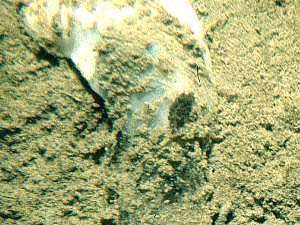
Note added 26 March 2009: I have reverted to the name Calliopaea bellula for this species. See Fact Sheet.
Hi Bill,
Following on from Philine aperta I enclose 3 scans of Stiliger bellulus. One shows a mass of individuals feeding on the eggs of Philine aperta (quality is poor as they were taken with a Nikonos close-up kit in poor visibility). Another photo taken at the same time shows a single animal on a Philine - hitching a ride? These were taken in Carlingford Lough during our Northern Ireland Survey in 1984 by Christine Howson and Dave Connor. The larger image is of an animal collected intertidally in NW Spain in 1978. Our database has records from several sheltered sites in SW Ireland where Philine was usually also present.
As a sacoglossan Stiliger bellulus might be expected to feed on algae, but these observations suggest that it feeds on Philine eggs (and possibly other
Opisthobranch eggs). In 1974 Lemche described a new species Calliopoea oophaga (named from its habit of eating Philine eggs) but this description is likely to be based on juvenile Stiliger bellulus (see Thompson & Brown, Biology of Opisthobranch Molluscs, p.167 for discussion). Thompson also mentions that the Mediterranean species Stiliger vesiculosus is oophagous.
Bernard
bernard.picton.um@nics.gov.uk
Picton, B., 1999 (Mar 16) Stiliger bellulus an egg-eating sacoglossan. [Message in] Sea Slug Forum. Australian Museum, Sydney. Available from http://www.seaslugforum.net/find/680Dear Bernard,
Thanks for this interesting observation. Have you ever found it feeding on algae or is it only found on eggs or "in transit".
Best wishes,
Bill Rudman.
